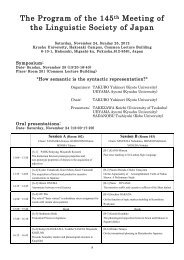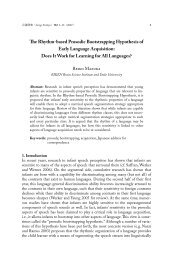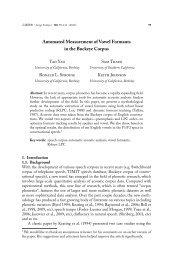第117åæ¥æ¬è§£åå¦ä¼ç·ä¼ã»å ¨å½å¦è¡éä¼ è¬æ¼ããã°ã©ã ã»æé²é PDF ...
第117åæ¥æ¬è§£åå¦ä¼ç·ä¼ã»å ¨å½å¦è¡éä¼ è¬æ¼ããã°ã©ã ã»æé²é PDF ...
第117åæ¥æ¬è§£åå¦ä¼ç·ä¼ã»å ¨å½å¦è¡éä¼ è¬æ¼ããã°ã©ã ã»æé²é PDF ...
You also want an ePaper? Increase the reach of your titles
YUMPU automatically turns print PDFs into web optimized ePapers that Google loves.
117 163<br />
P<br />
The metabolism of cholesterol after bile duct degeneration in lamprey<br />
Mayako Morii 1 , Yoshihiro Mezaki 2 , Noriko Yamaguchi 2 , Kiwamu Yoshikawa 2 ,<br />
Mitsutaka Miura 2 , Katsuyuki Imai 2 , Taku Hebiguchi 1 , Ryo Watanabe 1 ,<br />
Hiroaki Yoshino 1 , Haruki Senoo 2<br />
1<br />
Department of Pediatric Surgery, Akita University Graduate School of Medicine,<br />
2<br />
Department of Cell Biology and Morphology, Akita University Graduate School<br />
of Medicine<br />
Lampreys are unique vertebrates in that they lose biliary trees entirely during<br />
the metamorphosis. Despite the biliary atresia, lampreys do not develop neither<br />
biliary cirrhosis nor liver dysfunction. In other vertebrates, obstruction of bile<br />
ducts results in fatality because of the cytotoxicity of bile salts. It means that<br />
lampreys have evolved to use another metabolic pathway of bile juice in order<br />
to evade the cholestasis. However, molecular mechanism of this pathway is still<br />
unknown. The aim of this study is to investigate the way how the lamprey avoid<br />
the pathological consequence of cholestasis. We have cloned the cDNA sequences<br />
of two kinds of P450, which show high degree of homology with mammalian<br />
CYP7A1 and CYP27A1, respectively. We are now evaluating the expression<br />
levels of the mRNA for these genes in liver, gonad, gill, heart and intestine along<br />
with the temporal expression profiles from larva to adult. The present study<br />
suggests how and where bile acids are detoxified in adult lampreys. Understanding<br />
how lampreys avoid cholestasis could be valuable for progress in the treatment of<br />
human obstructive cholangiopathy.<br />
P<br />
NAFLD <br />
<br />
1 1 1 2 1<br />
1<br />
2 <br />
<br />
<br />
NAFLD NAFLD <br />
NASH NAFLD <br />
NASH <br />
9 C57BL/6 MCD <br />
30 M R MCD 8 16<br />
30 2 AST, ALT <br />
<br />
M 2 AST, ALT <br />
NAFLD <br />
10 <br />
M 16 CD68 <br />
CD68 <br />
R 3 <br />
R 16 <br />
MCD 16 CD68 <br />
30 <br />
CD68 <br />
<br />
P<br />
Deltalike <br />
<br />
<br />
<br />
<br />
Deltalike3 DLL3 <br />
DLL3 <br />
Huh2 DLL3 <br />
<br />
AnexinV TUNEL singlestrand DNA <br />
DLL3 Huh2 <br />
DLL3 binding<br />
assay DLL3 Small G Cdc42 <br />
CRIB <br />
DLL3 HuH2 Cdc42 <br />
PAK1 MAP kinase <br />
DLL3 <br />
<br />
DLL3 Cdc42 PAK1 MAP kinase <br />
<br />
P<br />
<br />
1 2 2 2 1<br />
1<br />
2 <br />
<br />
<br />
CLD<br />
<br />
<br />
<br />
<br />
ICR 85O 2 <br />
RA21Air 14 <br />
RA 7 RA14 Air14d<br />
14 O 2 14dRA 21 Air21dO 2 Air21d<br />
4%PFA<br />
<br />
O 2 14d <br />
O 2 <br />
Air21d <br />
<br />
<br />
CLD <br />
<br />
P<br />
CEACAM <br />
1 Nabil Eid 1 2 1 1<br />
1<br />
2 <br />
<br />
prox1 <br />
<br />
Carcinoembryonic cell adhesion molecule1 CEACAM1 <br />
CEACAM1 <br />
VEGFC <br />
BJMC338 VEGFC <br />
BJMC3879 <br />
2 CEACAM1, <br />
VEGFR3VEGFR3 <br />
phosphotyrosine <br />
VEGFA <br />
BJMC3879 <br />
CEACAM1 BJMC3879 <br />
CEACAM1 BJMC338<br />
BJMC3879 <br />
BJMC3879 VEGFR3 <br />
BJMC3879 CEACAM1 <br />
VEGFC <br />
<br />
P<br />
The role of peritoneal lymphatic system on the human peritoneal<br />
dissemination<br />
Masahiro Miura 1 , Yutaka Yonemura 2 , Yoshio Endou 3<br />
1<br />
Department of Human Anatomy, Faculty of Medicine, Oita University, 2 NPO<br />
organization to support peritoneal dissemination treatment, 3 Department of<br />
Molecular Targeting Therapy, Kanazawa University<br />
The role of lymphatic microenvironment on cancer metastasis was studied.<br />
VEGFCgene transfectants of the gastric cancer cell lines were inoculated into<br />
the peritoneal cavity of nude mice. The tissue samples from human disseminated<br />
peritoneum were stained with 5,NaseALPase double staining and aniti<br />
VEGFR3 immunostaining. Mouse VEGFR3 gene expression was induced after<br />
inoculation. In the early peritoneal dissemination PD stage, newly lymphatic<br />
networks LN were detected in the periphery of the primary tumor. The main<br />
source of lymphatic dissemination may originate from the peritumoral LN. In the<br />
PD, three patterns of tumor lymphangiogenesis, namely centrifugal, centripetaland<br />
combination growth patterns were found. Free cancer cells invaded the numerous<br />
blind endings that came from extended subperitoneal LN. In the late PD stage,<br />
the number of LN decreased due to the destruction of cancer cells. In SEM<br />
observation, Macula cribriformis were seen in the diaphragmatic subperitoneal<br />
tissue layer and Morrison pouch. Lymphangioginesis including newly formed LN,<br />
induced by VEGFC is closely associated in formation of PD and lymph node<br />
metastasis mainly via the prelymphatic channels.







